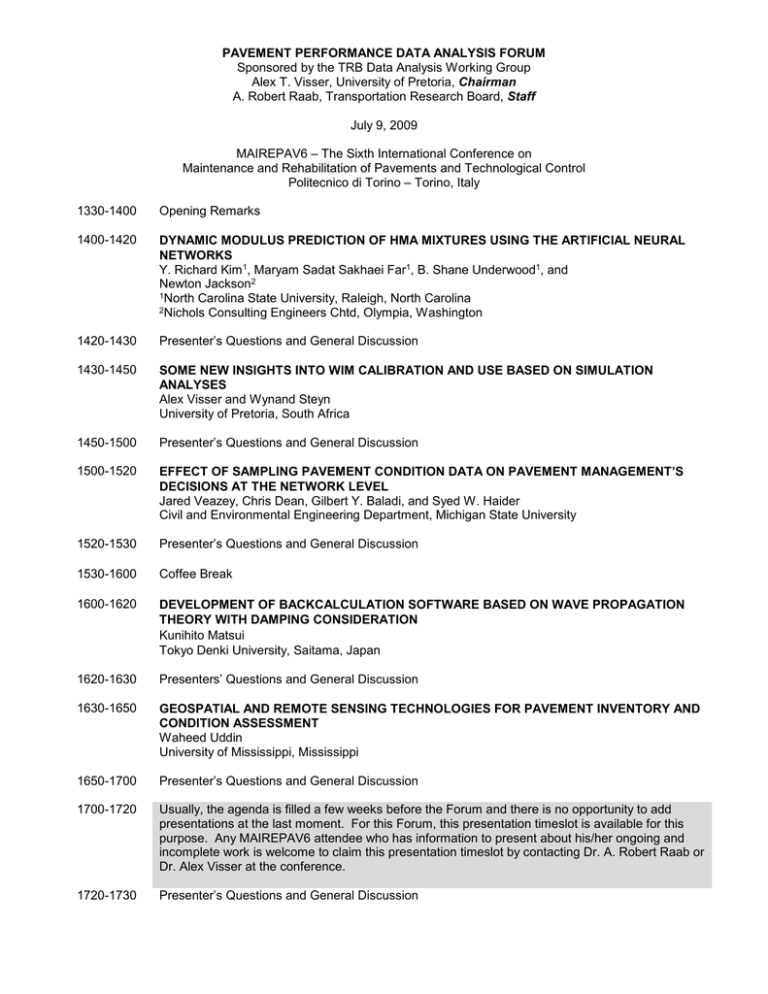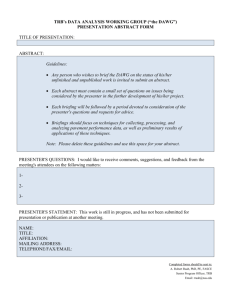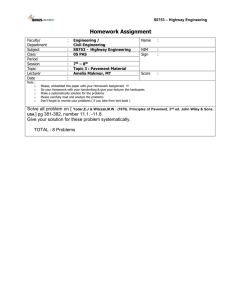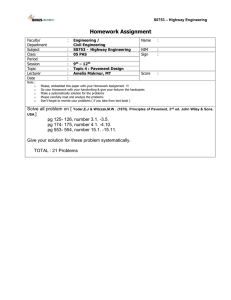PAVEMENT PERFORMANCE DATA ANALYSIS FORUM Chairman Staff
advertisement

PAVEMENT PERFORMANCE DATA ANALYSIS FORUM Sponsored by the TRB Data Analysis Working Group Alex T. Visser, University of Pretoria, Chairman A. Robert Raab, Transportation Research Board, Staff July 9, 2009 MAIREPAV6 – The Sixth International Conference on Maintenance and Rehabilitation of Pavements and Technological Control Politecnico di Torino – Torino, Italy 1330-1400 Opening Remarks 1400-1420 DYNAMIC MODULUS PREDICTION OF HMA MIXTURES USING THE ARTIFICIAL NEURAL NETWORKS Y. Richard Kim1, Maryam Sadat Sakhaei Far1, B. Shane Underwood1, and Newton Jackson2 1North Carolina State University, Raleigh, North Carolina 2Nichols Consulting Engineers Chtd, Olympia, Washington 1420-1430 Presenter’s Questions and General Discussion 1430-1450 SOME NEW INSIGHTS INTO WIM CALIBRATION AND USE BASED ON SIMULATION ANALYSES Alex Visser and Wynand Steyn University of Pretoria, South Africa 1450-1500 Presenter’s Questions and General Discussion 1500-1520 EFFECT OF SAMPLING PAVEMENT CONDITION DATA ON PAVEMENT MANAGEMENT’S DECISIONS AT THE NETWORK LEVEL Jared Veazey, Chris Dean, Gilbert Y. Baladi, and Syed W. Haider Civil and Environmental Engineering Department, Michigan State University 1520-1530 Presenter’s Questions and General Discussion 1530-1600 Coffee Break 1600-1620 DEVELOPMENT OF BACKCALCULATION SOFTWARE BASED ON WAVE PROPAGATION THEORY WITH DAMPING CONSIDERATION Kunihito Matsui Tokyo Denki University, Saitama, Japan 1620-1630 Presenters’ Questions and General Discussion 1630-1650 GEOSPATIAL AND REMOTE SENSING TECHNOLOGIES FOR PAVEMENT INVENTORY AND CONDITION ASSESSMENT Waheed Uddin University of Mississippi, Mississippi 1650-1700 Presenter’s Questions and General Discussion 1700-1720 Usually, the agenda is filled a few weeks before the Forum and there is no opportunity to add presentations at the last moment. For this Forum, this presentation timeslot is available for this purpose. Any MAIREPAV6 attendee who has information to present about his/her ongoing and incomplete work is welcome to claim this presentation timeslot by contacting Dr. A. Robert Raab or Dr. Alex Visser at the conference. 1720-1730 Presenter’s Questions and General Discussion A NOTE ABOUT “THE DAWG” TRB’s Data Analysis Working Group, “the DAWG”, is an international forum for the discussion of methods of analysis of pavement performance data. Presentations at DAWG-sponsored forums address the technical interests of professionals engaged in highway research and engineering design, maintenance, and rehabilitation who are engaged in collecting, processing, and analyzing such data and developing insights into the behavior of pavements. Presentations offered by forum attendees (by prior arrangement) focus on work-in-progress concerning the development of techniques for extracting and analyzing data, and early results of recent applications of these techniques. Topics such as model building, sensitivity analysis, and development of transfer functions linking structural response to distress are especially popular and welcome. A DAWG-sponsored forum has a minimum of formality to encourage open discussion among attendees and minimize the time between the presenters' preparation and dissemination of analytical results. The agenda is prepared in advance, based on responses to a call for abstracts. Abstracts are reviewed solely for conformity with DAWG guidelines, and as many as time permits are placed on the agenda. Presentations are not subjected to prior technical review. Copies of presentation materials are not distributed. Presentations are not published. Comments by forum attendees are not recorded. DAWG-sponsored forums are held twice each year: immediately preceding the TRB Annual Meeting in Washington DC in January, and approximately at the midyear at another location. The midyear meeting is usually held in conjunction with a major highway pavement conference where it is expected that many attendees will also be interested in participating in a DAWG forum. If requested by the organizers, the DAWG will arrange and conduct a formal paper session conforming to all the policies and procedures of the conference. As a TRB committee, the DAWG has appointed members who serve as a steering committee to guide the planning of future meetings. However, DAWG forums are open to everyone interested in the subjects to be discussed, and all attendees enjoy equal status. There is no registration requirement or fee required to attend meetings, but advance notice of the intent to attend a particular forum is recommended and appreciated. Inquiries are welcome from those interested in adding their names to the DAWG's mailing list, and those wishing to submit abstracts of presentations for consideration for presentation at a particular forum. Inquiries and abstracts should be directed to: Dr. A. Robert Raab Transportation Research Board 500 Fifth Street NW, Washington, DC 20001, USA Telephone: +1-202-334-2569 Fax: +1-202-334-3471 E-mail: rraab@nas.edu . DYNAMIC MODULUS PREDICTION OF HMA MIXTURES USING THE ARTIFICIAL NEURAL NETWORKS Y. Richard Kim1, Maryam Sadat Sakhaei Far1, B. Shane Underwood1, Newton Jackson2 1 North Carolina State University, Raleigh, North Carolina 2 Nichols Consulting Engineers Chtd, Olympia, Washington kim@ncsu.edu, mssakhae@ncsu.edu, bsunderw@ncsu.edu, NewtonCJ@aol.com ABSTRACT: This paper presents the development of a new, rational and effective set of dynamic modulus |E*| predictive models of hot mix asphalt (HMA) mixtures. These predictive models use Artificial Neural Networks (ANNs) trained with the same set of parameters used in the most recent revised equation of the Witczak model. To accomplish the goals for this study, modulus values from multiple mixtures and binders were required. These databases were assembled from existing national efforts and from data obtained at North Carolina State University (NCSU), and are basically from two types of SPT and TP62 protocols measured in different aging conditions. These databases include Witczak’s database, FHWA Mobile Trailer database, Citgo database, WRI Validation Site database for states of Nevada and Kansas, FHWA ALF database, and NCDOT database. The prediction models are developed using a portion of the data from these databases and then verified using the rest of data in the database. The results show that the predicted and measured |E*| values are in close agreement using these new ANN models. The main advantage of using ANNs for predicting the |E*| is that an ANN can be created for different sets of variables without knowing the form of the predictive relationship a priori. PRESENTERS’ QUESTIONS: We would like to receive comments, suggestions, and feedback from the meeting's attendees on the following matters: 1. Are there any other G* and E* databases that can be used for verification of the ANN models? 2. Has anybody done a sensitivity analysis of E* in the M-E PDG to see if there is a basis for establishing acceptable error bands for the prediction of E*? 3. Has anyone done a sensitivity analysis to establish which elements are needed to predict E*? PRESENTERS’ STATEMENT: This work is still in progress, and this aspect of the work has not been submitted for presentation or publication at another meeting. SOME NEW INSIGHTS INTO WIM CALIBRATION AND USE BASED ON SIMULATION ANALYSES Alex Visser and Wynand Steyn Department of Civil Engineering, University of Pretoria, South Africa alex.visser@up.ac.za, wynand.steyn@up.ac.za ABSTRACT: During the last 20 years weighing-in-motion (WIM) technology has developed rapidly. It has become a common data collection system, and is widely used. However, there are numerous papers at TRB and other conferences that try and make sense out of the data, or to relate dynamic mass to static mass as design procedures are based on static axle mass. This proliferation of publications is an indication that there is no standard solution to the problem. As part of the new South African mechanistic design method development an improved understanding of the interaction between road riding quality, measurement system and vehicle type, configuration and speed is required. The aim of this presentation is to share these new insights obtained from vehicle simulation. It shows that vehicle speed provides a major influence on the conversion of dynamic to static mass. This speed influence is not constant between vehicle type, and not even constant for the different axles on a particular vehicle. To solve this perplexing problem it is recommended that every WIM site be surveyed with a class 1 profilometer, and that a simulation study be conducted on the influence and possible adjustments for every WIM site, rather than trying to generate adjustment factors through field calibration. The field calibration would be used to validate the correct operation of the WIM system. PRESENTERS’ QUESTIONS: We would like to receive comments, suggestions, and feedback from the meeting's attendees on the following matters: 1. Is this presented approach feasible? Has anyone tried this approach? 2. Are there any issues that are being overlooked? 3. Would anyone try and apply such a system? PRESENTERS’ STATEMENT: This work is still in progress, and has not been submitted for presentation or publication at another meeting. EFFECT OF SAMPLING PAVEMENT CONDITION DATA ON PAVEMENT MANAGEMENT’S DECISIONS AT THE NETWORK LEVEL Jared Veazey, Chris Dean, Gilbert Y. Baladi, and Syed W. Haider Civil and Environmental Engineering Department, Michigan State University baladi@egr.msu.edu ABSTRACT: Some highway authorities collect pavement condition data on a continuous basis while others use sampling technique. Sampling technique is mainly used to reduce the time and costs of data collection. It is typically assumed that the pavement condition of any given pavement surveying length (e.g., one mile or one kilometer) can be represented by the conditions of the pavement along a shorter segment (such as 200 or 500 ft) along the survey section. In this paper, pavement distress data that were continuously collected along several miles of pavement networks were analyzed. The data were then used to simulate sampling. Two sampling methods were utilized in the analysis, (a) sampling of the first one tenth of a mile, and (b) random sampling of one tenth of a mile. In the first, it was assumed that the time dependent distress data of one tenth of a mile represent the distress data of the entire mile of the pavement. In the second, for every surveying cycle, the pavement conditions of a randomly selected one tenth of a mile were assumed to represent the pavement conditions along the entire mile. Two sources of data were utilized; Louisiana Department of Transportation and Development (LADOTD) and Michigan Department of Transportation (MDOT) Pavement Management Systems (PMS) data. The LADOTD PMS data were used to analyze the sampling of the first one tenth of a mile for roughness and rutting data. The MDOT PMS data were used to analyze the random sampling of one tenth of a mile for transverse cracking. PRESENTERS’ QUESTIONS: We would like to receive comments, suggestions, and feedback from the meeting's attendees on the following matters: 1. Does your agency use sampling as a mean for distress data collection? If so what sampling method(s) is used? 2. If your agency uses sampling method. Did you analyze the effects of sampling on the decision making processes? 3. If your agency collects continuous data, did you use the data to study the effects of sampling? PRESENTERS’ STATEMENT: This work is still in progress, and has not been submitted for presentation or publication at another meeting. DEVELOPMENT OF BACKCALCULATION SOFTWARE BASED ON WAVE PROPAGATION THEORY WITH DAMPING CONSIDERATION Kunihito Matsui Depart. of Civil and Environmental Engineering, Tokyo Denki University, Saitama, Japan matsui@g.dendai.ac.jp ABSTRACT: Although falling weight deflectometer (FWD) device exerts an impact load on the surface of a pavement, it is a general practice to regard peak FWD test results as static load and responses, backcalculation is performed to estimate pavement layer moduli. Although it is efficient, but it sometimes leads to erroneous results because of improper modeling used in forward analysis. Dynamic backcalculation has drawn increasing attention recently. However dynamic forward analysis is time consuming. This presenter had developed computationally efficient dynamic analysis software using FEM with Ritz vectors reduction in the past. Major shortcoming of FEM is mesh descritization which requires some experience. It is, therefore, important to develop analytic solution for wave propagation problem in which damping is implemented. In this study, three types of damping model are considered; density and stiffness proportional damping and complex modulus. The wave propagation problem is defined as axisymmetric problem, and solved applying Hankel transformation in a radial direction and FFT in a time domain. The followings will be presented: 1. Forward analysis procedure to solve a wave propagation problem is briefly explained. 2. Compare its results with that from dynamic analysis using ADINA, which is general-purpose FEM software in order to check its accuracy. 3. Forward analysis is conducted using different damping models, and their responses are compared. 4. Backcalculation is performed by using real FWD data, and the results are compared for the three types of damping. 5. Voigt type modeling is found best. PRESENTER'S QUESTIONS: I would like to receive comments, suggestions, and feedback from the meeting's attendees on the following matters: 1. Do you agree that Voigt type modeling is adequate for all layers? 2. Do you have any suggestion on a method which can replace FFT? PRESENTER'S STATEMENT: This work is still in progress, and has not been submitted for presentation or publication at another meeting. GEOSPATIAL AND REMOTE SENSING TECHNOLOGIES FOR PAVEMENT INVENTORY AND CONDITION ASSESSMENT Waheed Uddin University of Mississippi, Mississippi cvuddin@olemiss.edu ABSTRACT: This presentation describes the remote sensing and geospatial analysis methodology developed in a recent doctoral research work on the use of 1-m Ikonos imagery for road planimetrics and condition assessment after coastal disasters. The results of surface types are accurate within 7% of the groundtruth. This is a significant enhancement compared to about only 50% accurately classified pixels using traditional imagery analysis method. Based on the types of catastrophically damaged and severely distressed road infrastructure assets after Hurricane Katrina impacts, a new distress and damage rating methodology is proposed to quantify severe and catastrophic damages for emergency management. This presentation includes the current development of airborne and terrestrial Lidar systems for remotely collecting Lidar point cloud and intensity imagery data. Their application with intensity images for high-resolution 3D surface mapping offers great potential for nonintrusive pavement condition assessment and accurate 3D measurements of cracking and rutting. This spatial analysis may expedite calculation of Pavement Condition Index (PCI) and generate more accurate data for pavement performance modeling. PRESENTER'S QUESTIONS: I would like to receive comments, suggestions, and feedback from the meeting's attendees on the following matters: 1. Is the proposed distress and damage rating methodology helpful for assessment of damage to pavements and bridges after catastrophic events including floods? 2. Is the developed surface classification methodology for analyzing pre- and post- imageries useful to assess emergency maintenance needs related to catastrophic events and severe flood-induced damages? 3. Will the highway agencies be interested in the high-resolution three-dimensional remote sensing laser scanning of pavements to accurately assess rutting and cracking distresses. PRESENTER'S STATEMENT: This work is still in progress, and has not been submitted for presentation or publication at another meeting.




